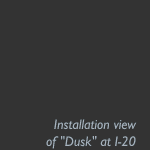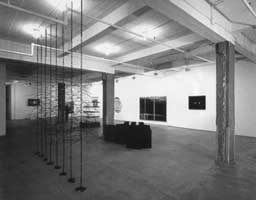


I first met curator, writer and editor David Hunt when he agreed to an interview at Silverstein Gallery in Chelsea. I imagined that he would be there organizing another show or writing a catalogue essay with the gallery owner, but was surprised to find that he, too, joins the ranks of gallery workers. My other misconception was that he would be in his late 30s, considering that he curated exhibitions in two New York galleries last season, he is the New York correspondent for artext, and he regularly writes for magazines like Flash Art and frieze, amongst many others. Instead, I was greeted by a man who couldn’t be much over 30 years old, a scenester not lacking in the art world requirements of cool glasses and funky shoes.
We sat down in his gracious employer’s back gallery, and before I could ask my first question, Hunt started to talk. He has plenty to say about ‘the art world’ and was eager to give me his opinion on the state of art writing. “Art writers are notoriously bad because it is a good way to start out. Because the pay is so low, art magazines don’t have the luxury of turning people away.” Thanks, Dave, nice to meet you, too.
So why does Hunt write and curate? “I started doing it because I just didn’t want to go to shows and have no connection. I am not an artist. I am not a dealer. So, and the curatorial aspect sprung out of the same thing. I was in Italy and I [thought]…I’m in this country. These people are being so nice to me. I might as well do something with it. So I curated a show of Italian video artists at…Gallery 16…when I went back to San Francisco.”
This exhibition led to others when he moved to New York in 1999. Over the past two years, Hunt has put together two shows in New York art galleries and written dozens of texts on the artists that interest him. He says that he aims to “…work with as many different galleries as possible…to maintain as many relationships as possible.”
“Dusk”, an exhibition which took place at the I-20 gallery last Fall, took its name from a time of day often associated with natural beauty and an element of intrigue. Hunt chose 20 works by different emerging artists whose work resists the romantic and ‘gothic.’ In a catalogue essay written in the form of an internal office memo from the marketing department of a company whose products are artists, Hunt elaborates on the heavily marketed concept of dusk (think photography magazines, think romantic couples) as beautiful and subverts it, pointing out that “any moment of the day can be beautiful.” At the same time, he tackles elements of what he sees as gothic subculture.
He explained to me that, “Dusk is about this anti-gothic sensibility….I just think that the whole gothic subculture is just so anachronistic….We’re coming back to the 80s. Before that we came back to the 70s. But gothic exists no matter what. It never goes away. There are always gothic clubs in every city. There are always people who…[have] pancake makeup on….And one of the elements of the art world is black.” Despite the vast difference between the ever-acceptable black clothing worn by art world denizens (Hunt himself was wearing at least two shades of black when we spoke), and the black leather and crushed velvet worn by goths, Hunt makes a mental connection between two distinctive styles of dress, and combines them under the rubric of impending darkness.
His next show, seen last summer at Caren Golden Fine Art, joined together no fewer themes under the title “Superimposition”. Given free reign in the gallery by Caren Golden, Hunt put together a tightly packed exhibition that included the work of another 21 emerging artists. For many, ‘superimposition’ referred to the process of constructing an image in layers, an organizing principle described by artforum.com reviewer Martha Schwendener’s as, “…impossibly, almost irrationally nebulous…” On the other hand, New York Times critic Holland Cotter turned the ambiguity into a positive point in his review, saying that, “One comes away reminded afresh of how much of interest there is to choose from these days and thinking how smart so many of Mr Hunt’s choices are.”
Speaking in outline form, Hunt set the scene for the exhibition: “The show was like an anti monochrome show. You noticed that there were no big fields. It was all over gestural mark making. You had to be working to the edge. Jim Lambie’s eye thing - tons and tons of eyes. Super, super imposition. Marsha Cottrell. Those computer drawings. All those lines. Thousands of little marks. That’s the type of stuff I am into. Supercomplexity.”
Complexity is what Hunt thrives on and the combination of unlikely themes in a single show has become his trademark. Last month, he opened his latest exhibition at MullerDeChiara, a new contemporary gallery in Berlin, co-directed by Laurie DeChiara of DeChiaraStewart in New York. The gallery’s inaugural exhibition is Hunt’s “Wattage and Friendship.” The inspiration for the show began with an article in The New Yorker magazine profiling an electricity resale company that encouraged its employees to sell electricity to friends and family. Hunt played on the idea that, “…the more power you have the more connectivity, the more friends you have. But really, the more alienated you are, the more you stay at home, the more acquaintances you have.”
Also in October, Hunt was asked to curate “Video Windows”, a selection of three video artists which changes monthly, at Stefan Stux Gallery. Taking the title, “Respirator”, the gallery will showcase work by Lila Friedland, Yorgo Alexopoulos and Jonathan Calm. More projects are on the horizon, including “Ursa Major” and “Druid: Wood as Superconductor”, two exhibitions slated to appear in New York galleries this season. My suggestion that Ursa Major, being a constellation of stars, might produce some art stars failed to win a smile. Instead, Hunt quickly related the constellation of the big bear to the bear market. “It’s about the market crash and more specifically the tech market crash – the NASDAQ. But it has two elements. One is the market crash and the other is this idea of day trading and people talking about the market as if it is a rational mechanism when really, it is just a kind of mystical, unpredicted mechanism. So there is artwork dealing with mystics, and psychics and cults…” “Druid…” also involves the mystical. It will include artists whose work in some way uses or references wood, a low tech natural object which cannot be improved by technology.
Hunt chooses a range of young artists, some better known than others. Matt Bakkom, for one, appears in every show. How can Hunt find relevance in Bakkom’s work for every show? “I just like the guy’s ideas. I mean, all of his ideas are good. Sometimes it’s like that. Some people are one trick ponies. This guy, he has the whole stable.”
Hunt’s own sense of disbelief that he has been able to achieve so much in such a short time and without a ‘proper’ art background kept coming up in our conversation. He reminded me several times that he is self-taught when it comes to art (his BA was in English) and has been living in the city only a little more than two years. Maybe it is his self-perceived outsider status that gives him a unique curatorial perspective. His ambition doesn’t hurt either.
To add to the success that Hunt has had in promoting exhibition ideas to gallerists, he has been well received by critics. Part of his appeal as a curator lies in his ability to showcase so many young artists while tying their work into his sometimes abstract themes. Both “Dusk” and “Superimposition” were shows that could have easily washed over the heads of gallery visitors who look at art like they shop for groceries – speeding down the aisles ticking off shows they’ve ‘picked up’. But for those with a little more time on their hands, Hunt’s work leaves much to be discovered.
In both his curatorial and writing styles, Hunt expresses his thoughts by making a steady stream of pop cultural references. Written in rapid fire, stream of consciousness prose, his catalogue essays and critical writing can be difficult to untangle. Caren Golden read a passage to me from one particularly dizzying catalogue essay on the artist, John Kalymnios. She concluded enthusiastically that, “this is an introduction to a catalogue of someone’s artwork that takes us to Kubrick, Spielberg, Rodney Brooks, Star Troopers, Robot Wars, Star Wars and Beckett in the first paragraph….He is coming from a fresh point of view. He doesn’t have to use the grad school lingo….I found it so high energy and fresh.”
Caren Golden isn’t the only one who thinks Hunt has hit upon a new way of curating. When asked by The Art Newspaper recently to name the best recent show in New York, Whitney Museum contemporary art curator Laurence Rinder picked “Dusk”, saying that, “I saw works by a number of artists whose work I hadn’t known of before and thought that David explored the theme in a fresh, unexpected way.” By putting together exhibitions crowded with the latest talent, Hunt reminds viewers of the role that galleries should play as laboratories for developing new ideas in art and in contemporary culture. History may be written by the slower moving museums, but it is in galleries that experimentation can take place. It might not be easy to encounter 20-something works by different artists in an average sized gallery space or digest a stream of cultural references in a catalogue essay, but there is enjoyment in the challenge.
Toward the end of our talk, Hunt cast some light on his technique for choosing the artists for his shows, saying, “I’m really into novelty…If it’s interesting right now and it’s not interesting next week, well…I don’t really have a problem with it. If it gets people excited for that amount of time then that’s a cool thing. I’d rather see that than…” Like he did many times during our talk, he trailed off before changing tack. Our interview ended in much the same way when, in midsentence (his, not mine), I turned around to find him gone. He had raced out of the gallery to intercept an artist, and so I left him doing what he seems to do best – following hard on the heels of the new and novel.